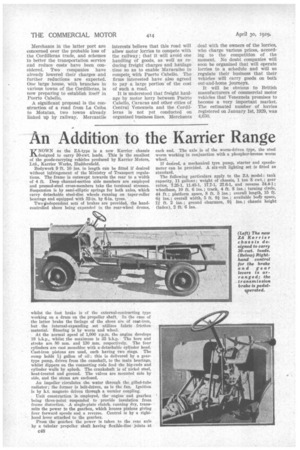An Addition to the Karrier Range
Page 78

If you've noticed an error in this article please click here to report it so we can fix it.
KNOWN as the ZA-type is a new Karrier chassis designed to carry 30-cwt. loads. This is the smallest of the goods-carrying vehicles produced by Earlier Motors, Ltd., !Carrier Works, Huddersfield, Bodywork 9 it. 10 ins, in length can be fitted if desired without infringement of the Ministry of Transport regulations. The frame is outswept towards the rear to a width of 4 ft. Deep channel-section side members are employed and pressed-steel cross-members take the torsional stresses. Suspension is by semi-elliptic springs for both axles, which carry detachable steel-disc wheels running on taper-roller bearings and equipped with 32-in. by 6-in. tyres.
Two*ndependent sets of brakes are provided, the handcontrolled shoes being expanded in the rear-wheel drums, whilst the foot brake is of the external-contracting type working on a drum on the propeller shaft. In the case of the latter brake the facings of the shoes are of cast-iron, but the internal-expanding set utilizes fabric friction material. Steering is by worm and wheel.
At the normal speed of 1,000 r.p.m. the engine develops 19 b.h.p., whilst the maximum is 35 b.h.p. The bore and stroke are 80 mm. and 130 mm. respectively. The four cylinders are cast monobloc with a,detachable cylinder bead. Cast-iron pistons are used, each having two rings. The sump holds 13. gallon of oil; this is delivered by a gear. type pump, driven from the camshaft, to the main bearings, whilst dippers on the connecting rods feed the big-ends and cylinder walls by splash. The crankshaft is of nickel steel, heat-treated and ground. The valves are mounted side by side, and the stems are enclosed.
An impeller circulates the water through the, gilled-tube radiator; the former is belt-driven, as is the fan. Ignition is by h.t. magneto driven through a vernier coupling.
Unit construction is employed, the engine and gearbox being three-point suspended to provide insulation from frame distortion. A single-plate clutch, running dry, transmits the power to the gearbox, which houses pinions giving four forward speeds and a reverse. Control is by a righthand lever attached to the gearbox.
From the gearbox the power is taken to the rear axle by a tubular propeller shaft having flexible-disc joints at C48 each end. The axle is of the worm-driven type, the steel worm working in conjunction with a phosphor-bronze worm wheel.
If desired, a mechanical tyre. pump, starter and speedometer can be provided. A six-volt lighting set is fitted as standard.
The following particulars apply to the ZA model: tank capacity, 11 gallons ; weight of chassis, 1 ton 8 cwt.; gear ratios, 7.25-1, 11.45-1, 17.7-1, 27.6-1, and reverse 34.4-1; wheelbase, 10 ft. 6 ins.; track, 4 ft. 8 ins.•, turning circle, 44 ft.; platform space, 8 ft. 5 ins.; overall length, 15 ft. 6i ins.; overall width, 5 ft. 9i ins.; available body space,
12 ft. 2 ins.•' ground clearance, ins.; chassis height (laden), 2 ft. 6 ins.




























































































































